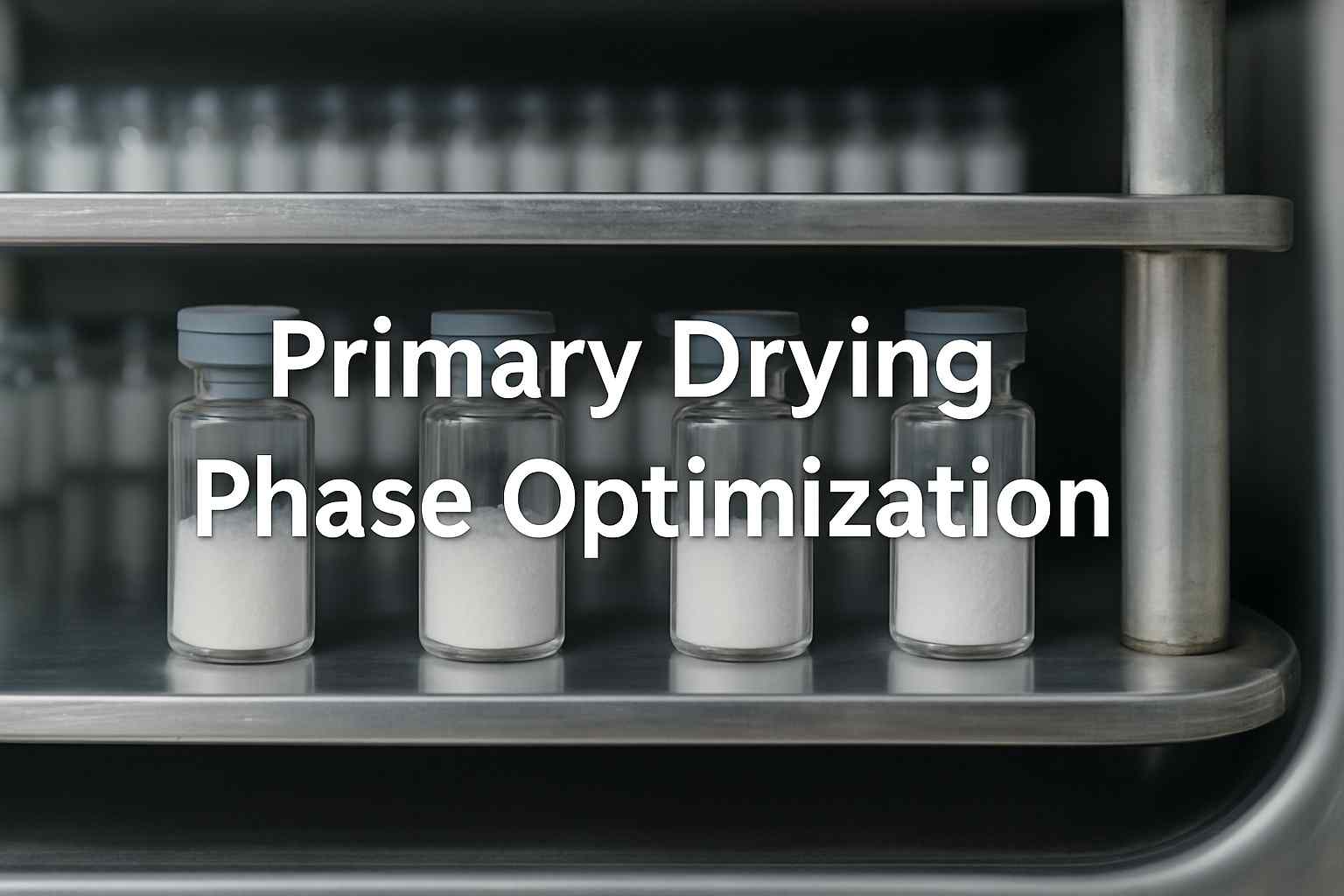Primary drying phase optimization is critical in pharmaceutical freeze-drying, as it represents the longest and most energy-intensive step in the entire lyophilization cycle. Optimizing this stage can drastically improve efficiency, reduce production time, and enhance product quality. With growing demands for GMP compliance, cost-effectiveness, and speed in biopharmaceutical manufacturing, researchers and engineers are focusing on minimizing primary drying duration without compromising product integrity.
Lyophilization is typically divided into three steps: freezing, primary drying, and secondary drying. Among these, the primary drying stage involves sublimating frozen solvent under low pressure and temperature. If not properly managed, this phase can lead to collapsed cakes, poor aesthetic quality, or even product degradation. Therefore, accurate modeling and optimization of shelf temperature and chamber pressure become vital.
Modern advancements in modeling have introduced dynamic, stochastic frameworks to optimize primary drying. These models take into account varying operating conditions, heterogeneous vial behavior, and mass-transfer constraints. Through calibration, validation, and nonlinear optimization, a reduction of up to 20% in drying time has been achieved without affecting visual or compositional quality.
Why Primary Drying Is a Bottleneck in Lyophilization
The primary drying phase is not just lengthy—it also consumes a large portion of the process energy. For pharmaceutical products like vaccines, enzymes, and monoclonal antibodies, maintaining a strict thermal profile is essential to avoid structural degradation. However, balancing sublimation speed with temperature constraints is complex.
Key goals of optimization include:
- Preventing product temperature from exceeding collapse/eutectic limits.
- Ensuring pressure stability to avoid vapor choke.
- Minimizing drying time to boost batch productivity.
Traditionally, industry has relied on conservative recipes using fixed shelf temperature and chamber pressure. While this ensures safety, it often results in overprocessing. As a result, the potential for efficiency gains through primary drying optimization is enormous.
Modeling Framework for Primary Drying Optimization
To achieve optimization, a stochastic modeling framework is used, involving:
- Model Development
- Sensitivity Analysis
- Model Calibration
- Model Validation
- Dynamic Optimization
Key Parameters Tracked:
- Product temperature
- Sublimation rate (water vapor flow)
- Remaining ice layer thickness
The model simulates how varying shelf temperatures and chamber pressures affect these KPIs, considering both central and edge vials in the chamber.
Addressing Real-World Challenges in Optimization
1. Time-Varying Operating Conditions
Using dynamic energy balances, the model adapts to real-time changes in shelf temperature and chamber pressure, unlike conventional static models.
2. Chamber Heterogeneity
Drying is not uniform across the chamber. Edge vials face higher radiation and faster sublimation, risking overheating. By integrating parametric uncertainty, the model simulates this heterogeneity.
3. Constraint Fulfillment
Optimized profiles ensure:
- Product temperature remains below collapse threshold.
- Sublimation rate does not exceed condenser capacity.
Experimental Validation: A 20% Time Reduction
The proposed model was tested against industry-standard freeze-drying protocols:
- Standard Protocol: Constant shelf temperature and pressure
- Optimized Protocol: Dynamically changing shelf temperature and pressure
Results:
- Standard primary drying time: ~24 hours
- Optimized protocol: ~18.2 hours (20% reduction)
Both edge and central vials retained excellent physical integrity, with no product rejection. A minor deviation (1°C) in a single edge vial was within acceptable tolerance.
Final Product Quality Assessment
Post-drying, visual inspections confirmed uniform structure and minimal shrinkage. Edge vials showed slight wall shrinkage but met GMP standards. Secondary drying was executed under standard parameters, and total cycle efficiency improved without any compromise on safety or compliance.
Conclusion:
Primary drying phase optimization stands as a transformative approach in pharmaceutical manufacturing. With well-calibrated models and dynamic optimization, manufacturers can significantly reduce drying time while safeguarding product quality. The integration of stochastic variability and nonlinear programming provides a robust, scalable framework ready for industrial implementation.
For more insights on lyophilization system performance, visit our article on Freeze Dryer IQ OQ PQ Validation Protocols.
✅ Internal link
- 🔗 https://asitafreezedryer.com/dry-layer-resistance-during-primary-drying/
→ Helps explain how resistance impacts heat and mass transfer efficiency during primary drying. - 🔗 https://asitafreezedryer.com/pressure-rise-test-in-lyophilization/
→ Relevant for discussing optimization and monitoring techniques. - 🔗 https://asitafreezedryer.com/importance-of-shelf-temperature-uniformity/
→ Crucial when discussing heat input control. - 🔗 https://asitafreezedryer.com/role-of-chamber-pressure-in-primary-drying/
→ Directly connects to controlling mass transfer rate. - 🔗 https://asitafreezedryer.com/thermocouples-in-lyophilization/
→ Useful for process control during the primary phase. - 🔗 https://asitafreezedryer.com/importance-of-freezing-in-lyophilization/
→ Discusses initial stage affecting sublimation behavior. - 🔗 https://asitafreezedryer.com/commissioning-of-lyophilization-units/
→ Ensures equipment readiness for efficient drying. - 🔗 https://youtu.be/FG5q3lmDQ8Y
🧠 Top 10 FAQs for the Article
What is the best freeze dryer for pharmaceutical manufacturing?
The best freeze dryer depends on production scale, regulatory needs, and process requirements, with top brands like Millrock, SP Hull, and IMA Life often preferred.
What features should I look for in a pharmaceutical freeze dryer?
Look for precise temperature control, vacuum integrity, CIP/SIP capability, and 21 CFR Part 11 compliance.
Why is vacuum control important in pharmaceutical freeze drying?
Vacuum control ensures sublimation occurs efficiently, which is critical for preserving product integrity and potency.
What size freeze dryer is ideal for small-scale pharma labs?
Benchtop or pilot-scale lyophilizers with modular scalability are ideal for R&D and small-batch production.
Is validation support necessary when choosing a freeze dryer?
Yes, full documentation (DQ, IQ, OQ, PQ) and validation services are essential for GMP compliance.
What are the leading freeze dryer manufacturers in the pharmaceutical industry?
SP Scientific, Telstar, Millrock Technology, Martin Christ, and IMA Life are industry leaders.
How does lyophilization improve drug stability?
It removes moisture at low temperatures, enhancing shelf-life, potency, and transport stability of heat-sensitive drugs.
What type of shelf temperature uniformity is required?
A high-end freeze dryer should maintain ±1°C uniformity across shelves during primary drying.
Can I integrate SCADA or PLC controls with pharmaceutical freeze dryers?
Yes, most modern freeze dryers offer SCADA/PLC integration for automated process monitoring and data logging.
Are there freeze dryers with nitrogen backfill and stoppering systems?
Yes, many GMP-grade freeze dryers offer nitrogen backfill, automatic stoppering, and advanced control systems.
